Yashica 35mm Snapshot Cameras & Specifications
Featured are the EZ-matic, ME, ME-1, MC, Mimy, Half Frame 14, Atoron and Flash-O-Set.
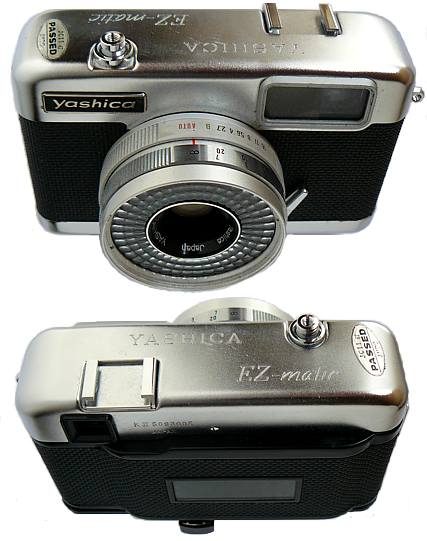 No roundup of snapshot camera would be complete without paying tribute, if that’s the word, to Kodaks’ disaster, the Instamatic format, second only to the "Kodak Disk" that almost single handedly killed off photography as a hobby.
No roundup of snapshot camera would be complete without paying tribute, if that’s the word, to Kodaks’ disaster, the Instamatic format, second only to the "Kodak Disk" that almost single handedly killed off photography as a hobby.
The Yashica EZ-matic is about the best of the breed of cameras designed for the format that I have seen. With a metal body, a 35mm lens with a maximum aperture of ƒ2.7, the camera has a ‘serious’ feel. The film advance lever slides across the bottom as smooth as silk.
A self energised photo cell of the cyclops eye variety, sets the correct exposure for the cassette in use automatically. The bottom measures 12 cm across, a bit under 4.75 inches wide. This camera needs to be included here because it obviously takes the Instamatic 35 cassette but often appears on auction described as either a 127 film format or a regular 35mm camera. It’s only value would be to a collector of this film format
The Yashica compact MC & ME do not have a split image rangefinder, so you need to estimate the distance from the camera to the subject yourself.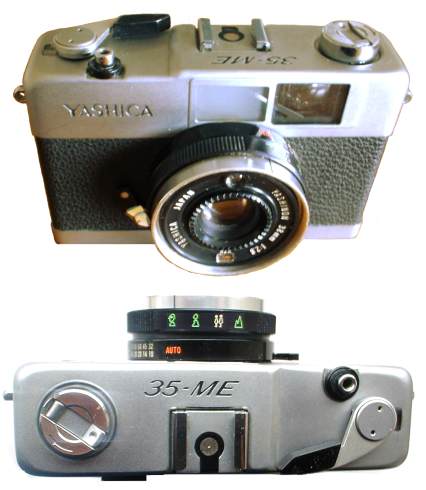 These cameras are referred to as ‘Zone Focus’. As you can see in the images kindly made available by John Cliffe in England, focus is facilitated by the addition of Icons representing the most typical viewing situations.
These cameras are referred to as ‘Zone Focus’. As you can see in the images kindly made available by John Cliffe in England, focus is facilitated by the addition of Icons representing the most typical viewing situations.
Matters are helped along by the employment of a short focal length lens which increases the depth of field considerably. The 38mm Yashinon ƒ2.8 lens gets excellent reviews for sharpness and colour correction.
In general, lenses with a focal length this short, introduce undesirable distortions in the perspective of close subjects. Although not nearly as serious as a true wide angle or fisheye lens, this is not the camera of choice for taking portraits.
By locating the light sensor within the lens group, filter factors are automatically compensated for. Another advantage as we have pointed out with models employing this feature.... you are unlikely to be able to keep shooting unless you take the lens cap off. The lower part of the lens group has a window, showing the selected ASA speed.
When the use of Flash is indicated by lighting conditions, the camera is moved from AUTO to the Guide Number for the flash in use.
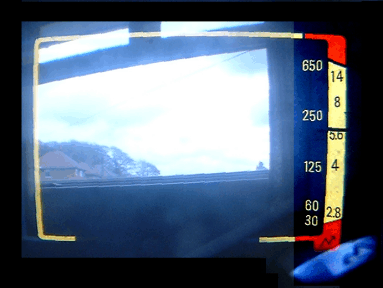 In this unique shot taken by John right through the finder, we can see the exposure indicated as approx 1/200 sec at f5.6. If the available light requires the use of Flash, the needle will fall to the Flash Icon.
In this unique shot taken by John right through the finder, we can see the exposure indicated as approx 1/200 sec at f5.6. If the available light requires the use of Flash, the needle will fall to the Flash Icon.
On the bottom right we can also see the Mountain Icon , which tells us that focus is set at infinity. This image is captured through the bottom right diagonal window on the front of the viewfinder, in case you wondered what that was all about.
Finally in answer to the question that we receive the most, the ME requires the use of a S76 / LR44 or SR44 1.5 V battery.
The MC uses a PX28A or 4LR44 6 V battery, commonly available. The description of the ME does not apply to the MC except in a very general way
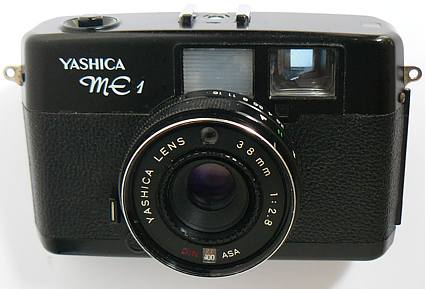 The ME-1 bares a slight resemblance to the earlier ME, in that they share similar viewfinder readout and lens / shutter combos, but that’s where it ends. This plastic body camera has the rewind lever folded down into the base plate. It uses an A76 battery to power the meter. A fresnel lens over the light gathering window should make the readout clearer than it’s predecessor, but I can’t check this because the auction seller misrepresented it to me and the finder system is shot. It’s as big as the Rangefinder CC model but extremely light. The camera was introduced in Japan in 1970 and in 1972 they turned up made in Brasil. If anyone knows if production was moved or they were made in both places at the same time, please contact me. The example shown above is marked ’Brasil’ on the baseplate. A word of caution, the camera is always on, so unless you have the lens cap on, the battery will run down rather quickly. Best to remove the battery when the camera is not in use.
The ME-1 bares a slight resemblance to the earlier ME, in that they share similar viewfinder readout and lens / shutter combos, but that’s where it ends. This plastic body camera has the rewind lever folded down into the base plate. It uses an A76 battery to power the meter. A fresnel lens over the light gathering window should make the readout clearer than it’s predecessor, but I can’t check this because the auction seller misrepresented it to me and the finder system is shot. It’s as big as the Rangefinder CC model but extremely light. The camera was introduced in Japan in 1970 and in 1972 they turned up made in Brasil. If anyone knows if production was moved or they were made in both places at the same time, please contact me. The example shown above is marked ’Brasil’ on the baseplate. A word of caution, the camera is always on, so unless you have the lens cap on, the battery will run down rather quickly. Best to remove the battery when the camera is not in use.
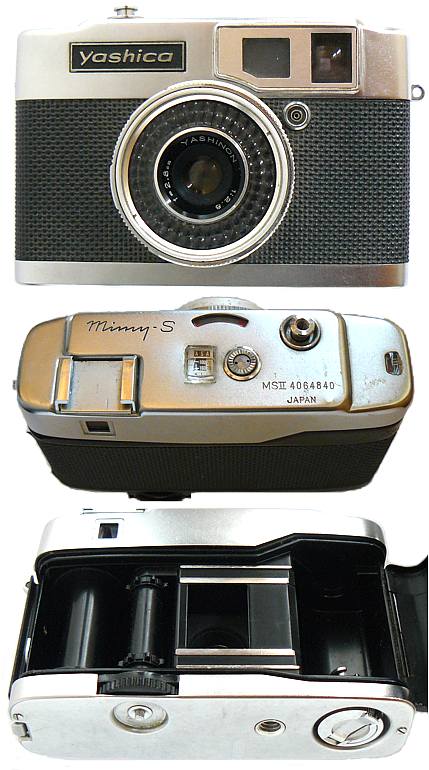 The Yashica Mimy S was first seen on store shelves in Japan in 1964. The concept here is to both reduce the size of the camera, since a lens required to cover an image of only a half frame wide,
The Yashica Mimy S was first seen on store shelves in Japan in 1964. The concept here is to both reduce the size of the camera, since a lens required to cover an image of only a half frame wide,
[ 18 X 24mm ] can be made smaller to provide both the economy of manufacture and the convenience of being able to shoot 72 frames without reloading, using a 36 exposure length of film required for a standard 35 camera.
Imagine having this capability while rappelling or while sky diving.
Now you may be thinking that the wind lever is missing, but you’d be wrong. The film is advanced by pushing on the thumb operated wheel seen on the bottom of the back view.
The rewind lever is nicely folded down into the bottom plate.
The lens has a focal length of 28mm with a maximum aperture of ƒ2.8. The second window on the front gathers the light for the frame-line indicator. The camera uses zone focus. The Aperture can be set to AUTO, Bulb or Manual. The meter needle Indicator gets it’s power from the Photo Electric cell surrounding the lens, no batteries required, still works on mine. Nice metal construction. The camera base plate measures a mere give or take, 4.25 inches or 10.8 cm in length. Half frame cameras appeared before WWII, but the format was popularized in the US by the Olympus Pen in the 1960s.
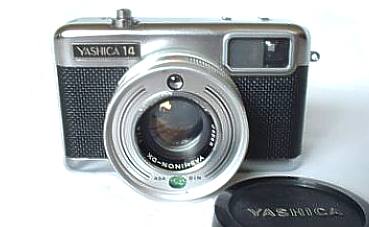
The updated Yashica Half Frame 14 model.
The images shown here were made available by Kiyoshe Watanabe, and are of the Yashinon DX ƒ1.4 lens version. It is most often found in the ƒ1.7 aperture version. The focal length is 32mm which should deliver a large depth of focus.
The exposure system is an update on the Mimy S as seen above. This is probably the only Half Frame Camera ever produced with such a large aperture.
And now as they say, “ for something completely different.” It's the Atoron Spy Camera.
Although it may have been handy for “Private Eyes“ snooping around, it was introduced after WWII and in any case due to its inability to take closeups, a film format of 8mm X 11mm, made the Atoron a dud even for industrial espionage.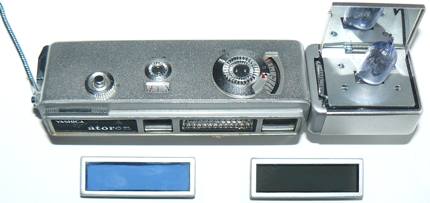
The Yashica Atoron is beautifully designed and finished. It uses a standard Minox film cartridge and comes in addition to a built in selectable Y2 Ultra Violet filter for B &W film, slide-on ND4 and 85B filters that cover the lens and photocell as shown below the camera. The detachable flash unit has a neat fold down reflector and uses a standard AG-1 peanut flashbulb. It is powered by two 23A 12V commonly used as remote garage door opener batteries.
It has been often said that the best camera, is the one that you have with you at the time that a photo opportunity presents itself, and given it's miniscule size [just 10 cm wide], you could do worse than a Yashica Atoron, film and processing availability permitting.
The Aperture setting ranges from ƒ16 to ƒ2.8 adjustable with an EV setting control on top of the camera. To figure out the EV system, I suggest bringing a laptop with suitable software with you. The shutter is automatically programmed.
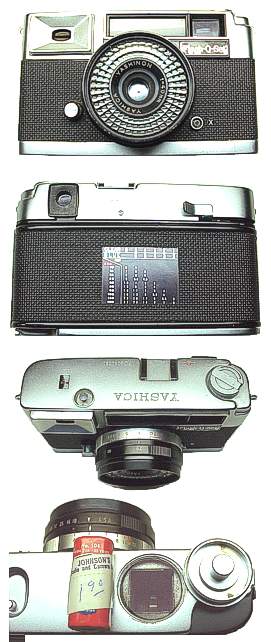
The Yashica Flash O Set was introduced in 1961, and makes it’s appearance here only to caution you, that while at first glance it may convince one that it is a rangefinder, you would be wrong. This Point & Shooter, while ostensibly designed to be simple to use, is actually a contraption that is hard to figure out even with the manual in hand.
Automatic Exposure is controlled by a self energized photo-electric cell through an ASA range of 10, it being the old Kodachrome speed and 50 which was the rating of Kodak Plus X available at the time. The shutter speed is fixed at 1/60th sec to provide reliable flash synch for the one time use peanut size AG-1 flash bulbs. A massive 15 Volt battery is used for this function, but is thankfully not required for any other purpose. An X synch PC socket makes it possible to use a strobe flash instead.
Don’t mistake the Yashinon lens with the superior optics of the Yashica Rangefinders that have the same lens designation. The Flash O Set has a 40mm fixed focus lens comprised of just 3 separate elements and a maximum aperture of ƒ4.0 with a claimed depth of focus ranging from 4ft. to Infinity.
The rear view shows the single stroke wind lever projecting a short distance below the top right and appears to be the master stroke of the masochist who designed this beast.
An over / under exposure indicator is viewable in the finder. Should the indicator fall in the over exposure zone, the use a neutral density filter is required, for beach or snow scenes. This is due to the shutter being fixed at the relatively slow speed of 1/60. A large N.D. filter that covers the entire photocell as well as the lens seems to have been included in at least some of the kits.
The top view shows the Flash Bulb Ejection Button. The Shutter Release is mounted on the front of the camera. A frame counter, cold flash shoe and rewind crank are all pretty much straight forward.
The final image shows the Eveready 15 Volt type Y 10 battery, with the holder and cover. The sprocket release button, that needs to be depressed before attempting to rewind the film, can be seen to the left.
We would like to hear your take on this site Send us an eMail ! via this link